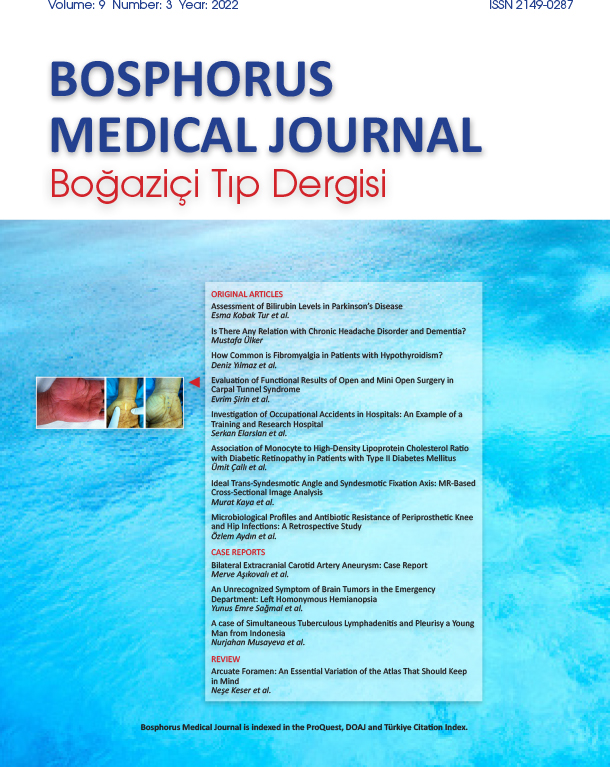Volume: 11 Issue: 2 - 2024
| FRONT MATTERS | |
| 1. | Front Matter Pages I - X |
| ORIGINAL RESEARCH | |
| 2. | Does Spondylarthropathy Cause an Increase in Irritable Bowel Syndrome? Sibel Süzen Özbayrak, Berna Günay, Nilgün Mesci, Duygu Geler Külcü doi: 10.14744/bmj.2024.09825 Pages 31 - 39 INTRODUCTION: The objectives were to determine the prevalence of IBS and gastrointestinal symptoms in people with psoriatic arthritis (PsA) and ankylosing spondylitis (AS), as well as to investigate the effects of eating habits, sleep disturbances, and depression on gastrointestinal symptoms. METHODS: The study included AS and PsA cases and also an age- and gender-matched control group for comparison. Demographic information was recorded, and disease activity was evaluated. All patients were asked about their IBS symptoms using the ROME III criteria and the Irritable Bowel Syndrome Quality of Life questionnaire. The Gastrointestinal Symptom Rating Scale, Beck Depression Inventory, Pittsburgh Sleep Quality Index, and Attitude Scale for Healthy Nutrition were also used. RESULTS: There was no statistically significant difference between the groups in terms of the frequency of IBS and gastrointestinal symptoms. Regarding the Beck Depression Inventory and the Attitude Scale for Healthy Nutrition, there was no statistically significant difference between the groups. In group analyses, there was no connection between IBS and gastrointestinal symptoms and the existence of depression, eating habits, or sleep disturbances. DISCUSSION AND CONCLUSION: There was no increase in the frequency of IBS and gastrointestinal symptoms in AS and PsA. Additionally, we found no correlation between sleep disturbances, eating habits, and depression scores in AS and PsA patients. |
| 3. | The Most Common Etiologies in Young Cryptogenic Strokes and Their Relationship with RoPE Score Leyla Ramazanoğlu, Beyza Karagöz, Işıl Kalyoncu Aslan doi: 10.14744/bmj.2024.35219 Pages 40 - 46 INTRODUCTION: This study was designed to determine the underlying etiologies and their relationship with the Risk of Paradoxical Embolism (RoPE) score in young cryptogenic stroke patients. METHODS: In the study, among 1434 patients who were treated with a diagnosis of transient ischemic attack/ischemic stroke in our neurology clinic between May 2021 and May 2023, 121 patients between the ages of 18-50 were evaluated retrospectively. The demographic characteristics of the patients, past medical history, admission and 24-hour National Institutes of Health Stroke Scale (NIHSS) scores, infarct localization, hospital stay, and 90-day modified Rankin score (mRS) were evaluated. RoPE scores were calculated for 48 patients who had no history of chronic disease and were considered to have cryptogenic stroke according to the Trial of Org 10172 in Acute Stroke Treatment (TOAST) classification. The study protocol was approved by the hospital ethics committee (2023/84). Artificial intelligence was not used in the article. RESULTS: The average age was 38.90, and 66.7% of the patients were male. The mean baseline NIHSS score was 4.65, and the most common stroke location (64.6%) was the MCA irrigation area. The most common etiology was Patent Foramen Ovale (PFO) with a rate of 37.5%. RoPE score was grouped as >7 and <7, and the relationship between TOAST etiology, NIHSS at admission and 24th hour NIHSS, duration of hospitalization, and Day 90 mRS and PFO closure was evaluated (p=0.381, p=0.509, p=0.447, p=0.591, p=0.884, p=0.500). DISCUSSION AND CONCLUSION: In our study, the most common cause detected in patients with a RoPE score > 7 was PFO. No significant relationship was found between RoPE score and PFO closure. No significant relationship was found between causes other than PFO and RoPE score. Although it is thought that evaluation with the RoPE score may be effective in cryptogenic strokes, further studies are needed to detect etiologies other than PFO. |
| 4. | Exploring the Impact of Inflammatory Indices on Non-Motor Symptoms in Parkinson's Disease: A Preliminary Study Esma Kobak Tur, Eren Gözke doi: 10.14744/bmj.2024.82787 Pages 47 - 53 INTRODUCTION: Emerging evidence shows that microglial activation and blood-brain barrier damage exacerbate inflammation in Parkinson's disease (PD) by linking peripheral and central immune responses. We aim to assess how peripheral inflammatory markers, including ratios like the neutrophil-to-lymphocyte (NLR) and neutrophil-to-high-density lipoprotein (NHR), affect the non-motor features of PD. METHODS: This study consists of 100 patients and 100 healthy controls. The standardized Mini-Mental State Examination (MMSE) was used to assess cognitive impairment, while the Non-Motor Symptoms Scale (NMSS) was utilized to evaluate non-motor features. According to the NMSS, patients were categorized as having mild, moderate, severe, or very severe symptoms. The neutrophil-to-lymphocyte ratio (NLR), platelet-to-lymphocyte ratio (PLR), neutrophil-to-HDL ratio (NHR), and systemic immune-inflammatory index (SII) values were calculated from the patients' peripheral blood samples and compared with those of the control group. RESULTS: The patients' average MMSE score was 20.57±4.09, significantly lower compared to the controls (p<0.05). Based on the NMSS classification, 9% of the patients had mild, 30% moderate, 26% severe, and 25% had very severe non-motor symptoms. No statistically significant correlation was observed between NMSS subgroups and inflammatory indices. In comparison to the control group, the patient group exhibited notably higher levels of NLR, NHR, and SII, while HDL and triglyceride levels were notably lower (p<0.05). According to the ROC analysis results, the NHR value was an excellent discriminator for PD, with an area under the curve (AUC) of 0.816 and a 95% confidence interval (CI) of (0.757-0.876). DISCUSSION AND CONCLUSION: Although our findings do not highlight the effect of inflammatory indices on non-motor features, they suggest that dyslipidemia and inflammation are involved in the pathophysiology of the disease. |
| CASE REPORT | |
| 5. | Cyst of the Canal of Nuck: A Very Rare Diagnosis Birol Ağca, Mehmet Timuçin Aydın, Yasin Güneş, Iksan Taşdelen, Nuriye Esen Bulut, Adnan Somay, Bedirhan Çoruhlu, Mehmet Mahir Fersahoğlu, Kemal Memişoğlu doi: 10.14744/bmj.2024.86094 Pages 54 - 56 Nuck canal hydrocele, also known as Nuck canal cyst or female hydrocele, is a very rare condition and is frequently misdiagnosed in the clinic. The association with inguinal hernia makes the diagnosis even more difficult. A 45-year-old patient who described swelling and pain in the right groin had no history of previous abdominal or pelvic surgery, or trauma. A reducible mass was detected in the right groin area during physical examination. An anechoic lesion measuring 60x17 mm was observed on superficial groin ultrasonography. A cystic lesion measuring 23x19x46 mm was observed on magnetic resonance imaging. The patient underwent cyst excision and hernia repair with laparoscopic total extraperitoneal (TEP) surgery. In histopathology, the cyst had a multilocular surface with a mesothelial structure containing single-row, sometimes several-row proliferation. A cystic lesion containing lining cells was detected. There is no standard treatment method for Nuck duct cysts. Although conservative treatment options such as aspiration or sclerotherapy have been reported for female hydroceles, hydrocelectomy with or without cyst ligation is recommended. |
| 6. | Meige Syndrome (Blepharospasm with Orofasial Dystonia): Two Case Reports Hatice Ferhan Kömürcü doi: 10.14744/bmj.2024.53336 Pages 57 - 59 Meige syndrome is a rare movement disorder characterized by involuntary spasms of the muscles around the jaw, tongue, and eyes. It may manifest idiopathically or secondary to an underlying cause. Herein, two cases diagnosed with primary and secondary Meige syndrome are reported, and the literature regarding their clinical findings and treatment approaches is reviewed. |
| 7. | Isolated Third Cranial Nerve Palsy Secondary to in-Vehicle Traffic Accident Without any Radiological Evidence Ceren Erkalaycı, Özge Akın Gökçedağ, Çisil İrem Özgenç Biçer, Eren Gözke doi: 10.14744/bmj.2024.64426 Pages 60 - 64 The oculomotor nerve is one of the twelve cranial nerves, and its isolated injury due to minor head trauma is a rare condition. Possible causes of this damage may include skull fracture, aneurysm, subarachnoid hemorrhage, carotid-cavernous fistula, or traumatic brainstem pathologies, but there may not always be such major pathologies that we can demonstrate with classical radiological imaging techniques. Here we report a thirty-six-year-old healthy woman who presented to the emergency department with diplopia caused by left-sided total oculomotor nerve palsy due to a minor car accident. Her classical imaging modalities were revealed to be normal. According to our literature review, the minor pathological impact on the oculomotor nerve at the posterior petroclinoid ligament segment could be the cause behind this clinical scenario. However, to reveal these kinds of minor changes, we need higher-resolution Magnetic Resonance Imaging (MRI) techniques. |




















